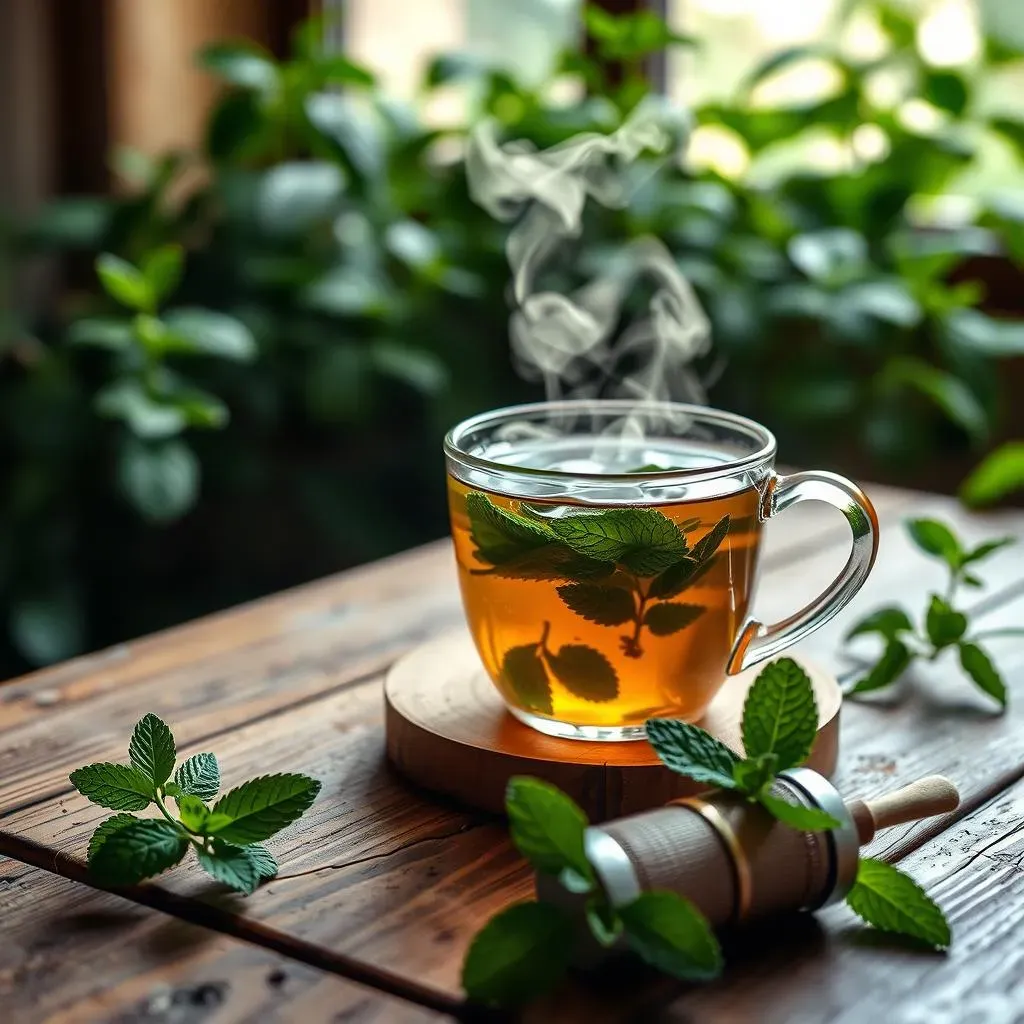Table of Contents
Feeling overwhelmed? Stress got you down? In today's fast-paced world, finding moments of peace can feel like a luxury. But what if I told you there's a simple, natural way to unwind and de-stress, right in your own kitchen? We're talking about the amazing benefits of spearmint tea for reducing stress. This isn't just some old wives' tale; scientific research supports the calming properties of spearmint. In this article, we'll explore the science behind spearmint's stress-relieving effects, guiding you through the art of brewing the perfect cup of tranquility. We'll also uncover creative ways to incorporate spearmint into your daily routine for a holistic approach to stress management, addressing any concerns you might have along the way. Get ready to discover how this humble herb can transform your approach to stress and help you find your center, one soothing sip at a time. Prepare to learn exactly how spearmint tea for reducing stress can become your new secret weapon against anxiety and tension. Let's dive in!
Spearmint Tea for Reducing Stress: The Science Behind the Calm
Spearmint Tea for Reducing Stress: The Science Behind the Calm
The Role of GABA
Let's talk science! Spearmint's calming effect is partly due to its interaction with GABA receptors in your brain. GABA, or gamma-aminobutyric acid, is a neurotransmitter that acts like a natural chill pill, slowing down brain activity and promoting relaxation. Think of it as your brain's built-in brake pedal. When stress kicks in, your brain goes into overdrive. Spearmint helps gently apply the brakes, easing anxiety and promoting a sense of calm. It's not a knockout drug; it's more like a gentle whisper of tranquility to your nervous system.
Studies have shown that compounds in spearmint can bind to these GABA receptors, enhancing their inhibitory effects. This means that spearmint can help reduce the intensity of stress signals reaching your brain. It's a subtle but significant shift – less frantic brain activity, more peace of mind. And isn’t that what we all crave when battling stress? For more ways to manage stress, check out our post on spearmint tea for stress relief.
Compound | Effect |
|---|---|
(-)-Carvone | Relaxes muscles, reduces spasms |
Menthol | Cooling, soothing effect |
Rosmarinic Acid | Antioxidant, anti-inflammatory |
Antioxidant Powerhouse
Beyond GABA, spearmint is packed with antioxidants. These natural powerhouses fight off free radicals, those pesky molecules that damage cells and contribute to inflammation – a major player in stress responses. Think of antioxidants as tiny superheroes protecting your cells from stress-related damage. By neutralizing free radicals, spearmint helps reduce inflammation throughout your body, leading to a more relaxed state. It's like giving your body a mini-spa treatment from the inside out.
This antioxidant action helps protect your brain and body from the harmful effects of chronic stress. Consistent stress can lead to various health problems, and spearmint's antioxidant properties can help mitigate some of these risks. This is why incorporating spearmint tea into your daily routine can be a smart move for overall well-being. If you're looking for more ways to boost your immune system, learn more about spearmint tea for immunity.
- Reduces inflammation
- Protects cells from damage
- Supports overall well-being
Hormonal Harmony
Here’s a fascinating twist: Spearmint may also influence your hormones, particularly in women. Some studies suggest that it can help balance hormone levels, which can significantly impact stress levels. Hormonal imbalances can contribute to anxiety, irritability, and mood swings—all unwelcome companions of stress. By potentially helping to regulate hormones, spearmint tea might indirectly lessen the intensity of stress-related symptoms.
While more research is needed to fully understand this connection, the potential for hormonal harmony adds another layer to spearmint's stress-relieving capabilities. It's not just about calming the nervous system; it's about creating a more balanced internal environment, making you more resilient to stress. Learn about other health benefits of spearmint in our article: Spearmint tea health benefits.
How to Brew the Perfect StressRelieving Spearmint Tea
How to Brew the Perfect StressRelieving Spearmint Tea
Choosing Your Spearmint and Water
First things first: the quality of your ingredients matters! Opt for fresh spearmint leaves whenever possible; their vibrant aroma and flavor are unmatched. If fresh leaves aren't accessible, good-quality dried spearmint works too. Just remember that dried leaves are more concentrated, so you might need to adjust the amount you use. For the water, spring water or filtered water is best—avoid using tap water, which can sometimes impart off-flavors.
The water temperature is crucial for unlocking spearmint's delicate flavors and beneficial compounds. Boiling water is too harsh; it can make the tea bitter. Aim for water that’s just off the boil, around 200-210°F (93-99°C). This allows the leaves to gently infuse without becoming overly bitter. Think of it as a Goldilocks situation: not too hot, not too cold, but just right! For more on the health benefits of spearmint, check out our guide on spearmint tea benefits.
- Fresh spearmint leaves are ideal
- Use filtered or spring water
- Water temperature: around 200-210°F (93-99°C)
Steeping and Serving Your Calming Brew
Once you've got your water and spearmint ready, it's time to brew! For a single cup, use about 1-2 teaspoons of fresh spearmint leaves (or 1/2-1 teaspoon of dried). Place the leaves in a tea infuser or directly in a mug if you prefer. Pour the hot water over the leaves, ensuring they're fully submerged. Cover the mug or teapot with a lid to trap the fragrant steam. Let the tea steep for 5-7 minutes—longer for a stronger brew, shorter for a milder one.
After steeping, remove the infuser or strain the leaves out. If you like, add a touch of honey or lemon for sweetness. However, I personally prefer the pure, slightly minty flavor. Enjoy your calming cup of spearmint tea slowly, savoring the aroma and the gentle warmth. Remember, this isn't just a drink; it's a moment of self-care. For more tips on using spearmint to improve your mood, see our article on spearmint tea for mood improvement.
Steeping Time | Strength |
|---|---|
5 minutes | Mild |
7 minutes | Medium |
10 minutes | Strong |
Beyond the Cup: Using Spearmint for Stress Relief in Other Ways
Beyond the Cup: Using Spearmint for Stress Relief in Other Ways
Aromatherapy: Breathe Easy
Beyond the comforting cup, spearmint offers aromatherapy benefits. Its refreshing scent can be incredibly calming, helping to ease anxiety and promote relaxation. Try adding a few drops of pure spearmint essential oil to a diffuser or inhale it directly from the bottle (a tiny amount!). This can be especially helpful before bed to improve sleep quality, further reducing stress. Think of it as a mini-spa session for your senses!
The power of aromatherapy shouldn't be underestimated. The olfactory system—your sense of smell—has a direct link to the limbic system in your brain, the area associated with emotions and memories. Inhaling spearmint's calming scent can trigger a cascade of relaxation responses, helping to quiet a racing mind and ease feelings of tension. For more on spearmint's impact on sleep, see our article on spearmint tea for sleep.
- Diffuse spearmint essential oil
- Inhale directly from the bottle (use sparingly)
- Add to a warm bath
Topical Application: Soothe Away Tension
Did you know you can also apply spearmint topically? Dilute a few drops of spearmint essential oil with a carrier oil like coconut or jojoba oil, and gently massage it onto your temples or the back of your neck. This can help relieve tension headaches and promote a sense of calm. The cooling sensation of the menthol in spearmint can be especially soothing for tight muscles, further contributing to stress reduction. It's like a mini-massage for your mind and body.
Remember, always dilute essential oils before topical application to avoid skin irritation. A patch test is always recommended before applying to larger areas of skin. The gentle massage itself can be therapeutic, adding to the overall relaxation effect. For additional ways to use spearmint for pain relief, see our article on spearmint tea for headaches.
Carrier Oil | Dilution Ratio |
|---|---|
Coconut Oil | 1 drop spearmint oil : 5 drops carrier oil |
Jojoba Oil | 1 drop spearmint oil : 5 drops carrier oil |
Spearmint Tea for Reducing Stress: Addressing Your Concerns and Finding Your Calm
Spearmint Tea for Reducing Stress: Addressing Your Concerns and Finding Your Calm
Is Spearmint Tea Right for Me?
You might be wondering if spearmint tea is the right choice for you. It's generally considered safe for most adults when consumed in moderate amounts as part of a balanced diet. However, like any herbal remedy, there are a few things to keep in mind. If you're pregnant or breastfeeding, it's best to consult your doctor before adding spearmint tea to your routine, as some studies suggest potential interactions with hormones. Similarly, if you're taking any medications, especially those affecting hormone levels or liver function, check with your doctor or pharmacist to rule out any potential drug interactions. It's always better to be safe than sorry!
Also, remember that spearmint tea isn't a miracle cure for stress. It's a complementary approach to stress management, best used in conjunction with other healthy habits. Think of it as a supportive tool in your overall wellness toolbox, rather than a magic bullet. For more information on managing stress, you might find our article on spearmint tea for stress relief helpful.
- Consult your doctor if pregnant, breastfeeding, or taking medication.
- Spearmint tea is a supportive tool, not a cure-all.
- Combine with other healthy lifestyle choices.
Addressing Potential Side Effects
While spearmint tea is generally well-tolerated, some individuals might experience mild side effects. These can include upset stomach, headaches, or allergic reactions (in rare cases). If you experience any adverse effects, discontinue use and consult a healthcare professional. Remember, everyone's body is unique, and what works for one person might not work for another. Pay attention to how your body responds to spearmint tea, and don't hesitate to adjust your intake or stop altogether if needed.
It's important to start slowly when incorporating spearmint tea into your routine. Begin with one cup a day and gradually increase your intake as you feel comfortable. This allows your body to adjust to the herb and helps you identify any potential sensitivities. Listen to your body's signals and don't push yourself beyond what feels comfortable. This mindful approach is key to reaping the benefits of spearmint tea without experiencing any unwanted side effects. To learn more about the potential digestive benefits of spearmint, check out our article on spearmint tea for digestion.
Possible Side Effect | Action |
|---|---|
Upset Stomach | Reduce intake or discontinue use |
Headache | Reduce intake or discontinue use |
Allergic Reaction | Discontinue use and consult a doctor |
Finding Your Calm: Integrating Spearmint Tea Into Your Life
Integrating spearmint tea into your daily routine is easier than you might think. Consider making it a part of your morning ritual or a relaxing evening wind-down. Find a time that works best for you and make it a consistent habit. Consistency is key when it comes to experiencing the full benefits of any herbal remedy. Think of it as a small act of self-care that you can build into your daily life, a moment to pause, breathe, and reconnect with yourself.
Don't be afraid to experiment with different ways to enjoy spearmint tea. Add a dash of lemon or a drizzle of honey if you like. Try adding it to iced tea for a refreshing summer drink. Get creative and find what works best for your taste buds! The most important thing is to find a way to make it a regular part of your life, a soothing ritual that helps you manage stress and enhance your overall well-being. To learn more about other ways to use spearmint for your health, see our article on spearmint tea health benefits.
